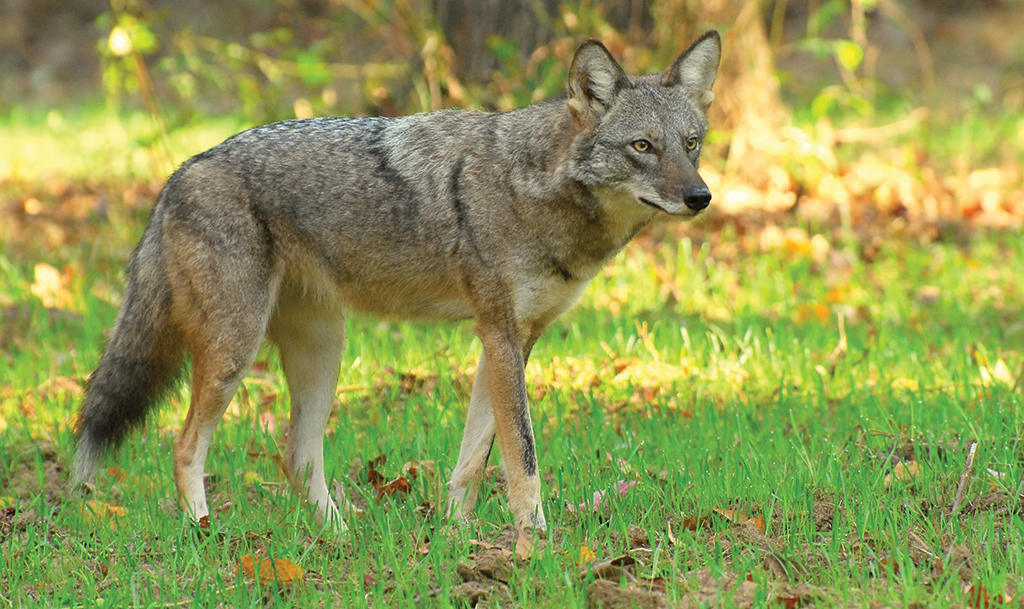
They live in every county in Alabama
By John N. Felsher
When early settlers moved into what became Alabama, they found an untamed wilderness full of powerful toothy creatures, some capable of attacking, killing and even eating humans. They heard cat screams and wolf howls just beyond the dark trees barely illuminated by the dancing campfire flames.
“Big cats were here,” says Richard Tharp, an Alabama Department of Conservation and Natural Resources game biologist in Enterprise. “Red wolves were native to Alabama, but they have been extirpated from the state, primarily from loss of habitat. Black bears still live in Alabama. Coyotes were originally a western species, but moved eastward in the past 50 years.”
In the early 1900s, some people released coyotes in Alabama as game animals after wolves disappeared. With forests cleared and lush crops attracting mice, rabbits, rats and other small animals and no competition from wolves, coyotes thrived. By the 1960s, coyotes naturally expanded eastward from their native range in western states to fill the void left by the vanished gray and red wolves. They now populate every state in the contiguous United States.
Red wolves, smaller cousins of gray or timber wolves, also ranged across the southeastern United States as far north as the Ohio River. But by 1921, only a few red wolves remained in the rugged hills of Walker and Colbert counties and they soon disappeared.
By the 1960s, a remnant wolf population still hunted the swamps of eastern Texas and southwest Louisiana. From 1973 to 1980, wildlife officers in that area trapped about 400 canines, but only 43 wolves. Of those, only 17 were genetically pure red wolves. The rest were wolf-coyote hybrids. In 1980, the U.S. Fish and Wildlife Service declared red wolves extinct in the wild.
Coyotes: Survivors and adaptors
“People have called me claiming to have seen a wolf, but it’s usually a coyote, feral dog or even a coyote-dog hybrid,” Tharp explains. “If they saw an actual wolf in Alabama, it’s probably an escapee from captivity. Many people think a coyote is a lot bigger than it really is and might believe it’s a wolf. Coyotes look bigger in the winter when they have thicker fur that gives them a fluffier appearance. Female coyotes in Alabama normally average 25 to 35 pounds. Males grow up to 45 pounds. A 45-pound coyote is a really big coyote.”
Incredibly adaptable, coyotes can live practically anywhere and eat anything. They survive in mountainous terrain, forests, agricultural lands, prairies, swamps and even marshes. They thrive all across Alabama and, unlike wolves, adapt well to living close to people. Highly elusive, coyotes can practically live in a person’s backyard without anyone even knowing it.
“Coyotes are survivors,” Tharp says. “Their feeding habits and their adaptability means they’ll probably be in Alabama from now on. They do very well in wooded, agricultural and even suburban areas. They are in every county in Alabama, including our major metropolitan areas. If there’s ever a nuclear war, cockroaches and coyotes will probably survive it.”
Adept predators, coyotes usually eat mice, rats, rabbits and other small animals, but won’t hesitate to eat anything else they can catch. They also eat carrion and vegetable matter. They’ll eat insects, fruits, vegetables, roots, garbage, pet food and just about anything else they find.
“Coyotes normally hunt from dusk to dawn,” Tharp says. “People sometimes see them in daylight, especially when they have young and the parents are working extra hard to find something for the little ones to eat, but usually, they’re out in low light conditions.
A threat to pets
“Coyotes are definitely a threat to pets, especially ones left outside at night. They sometimes eat small cats and dogs, particularly in urban or suburban areas. Some people put up fences with roller-type spinning bars at the top. When a coyote steps on it, it rolls and the animal falls off. If there’s nothing to attract coyotes to someone’s yard, they’ll go elsewhere.”
Occasionally, coyotes breed with dogs, creating a hybrid called a coydog. They would most likely mate with larger dog breeds, such as shepherds or hounds, and sometimes they mate with feral dogs.
“Coydogs are fairly rare in Alabama,” Tharp emphasizes. “There are some coydogs in Alabama, but probably not as many as people believe. It’s possible for a coydog to be larger than a pure coyote and less afraid of humans. That depends upon the type of dog that put genetic information into that animal.”
Many people fear coyotes, but dogs, wild or pets, kill about 15 to 20 people in Alabama each year. Coyotes very rarely attack people. They might bite someone when cornered or threatened, but generally try to avoid people.
“In my opinion as a biologist, a wild dog is much more of a threat to humans than a coyote because dogs do not have a natural fear of humans like some other animals,” Tharp explains. “The first instinct for a wild animal like a coyote is to get away from humans. When they encounter people, they normally slink away. If someone ran into an animal that’s overly aggressive, that person needs to back away from it. It could be wounded or sick. Coyotes can carry rabies.”
In Alabama, people can hunt coyotes all year long without limit on private lands. They can also hunt them on most public lands in conjunction with other open seasons. Landowners can apply for wildlife control permits that allow them to shoot coyotes at night. Consult the nearest wildlife department office for more information.




